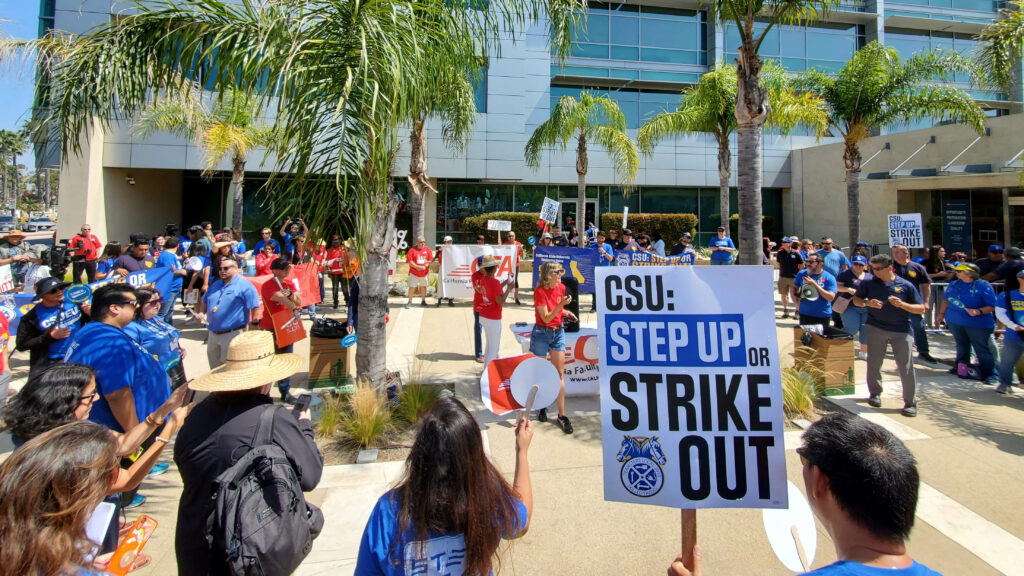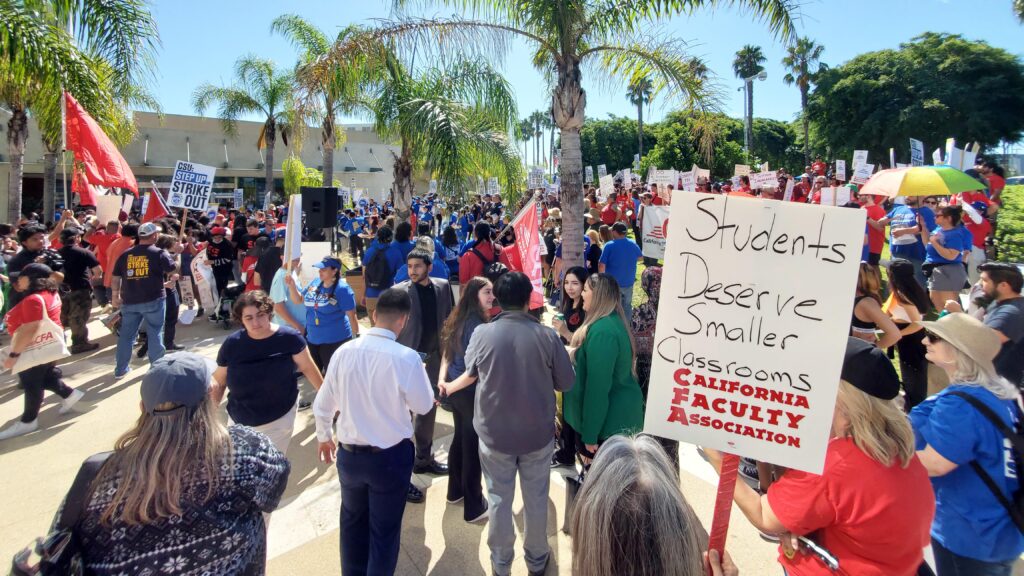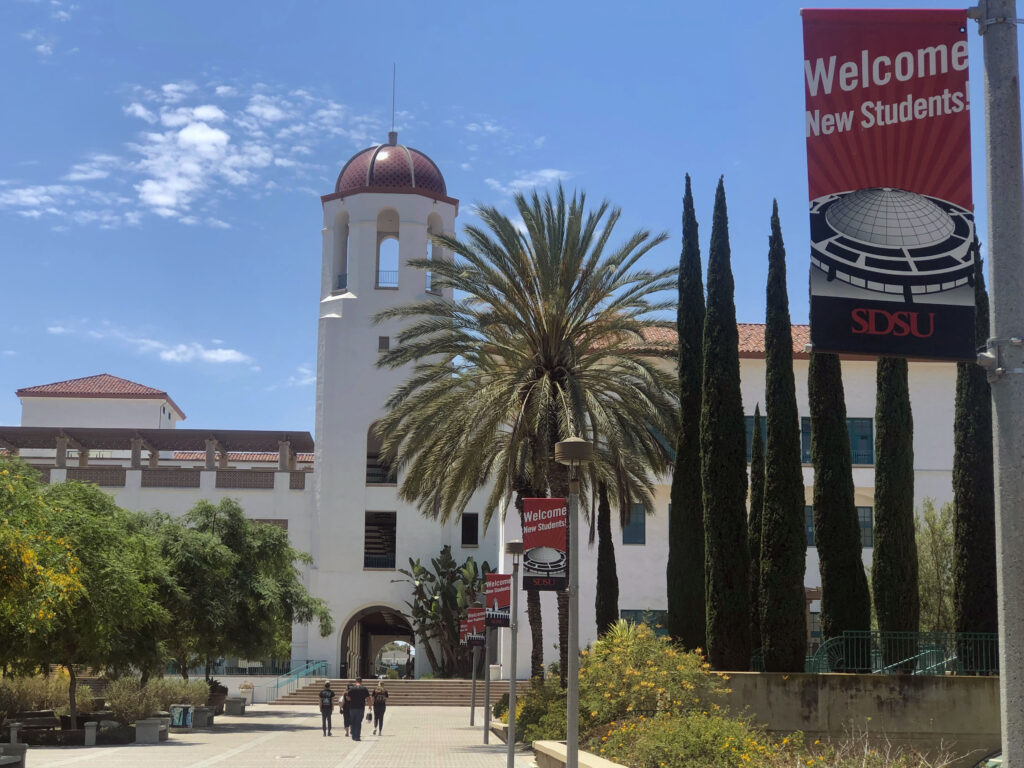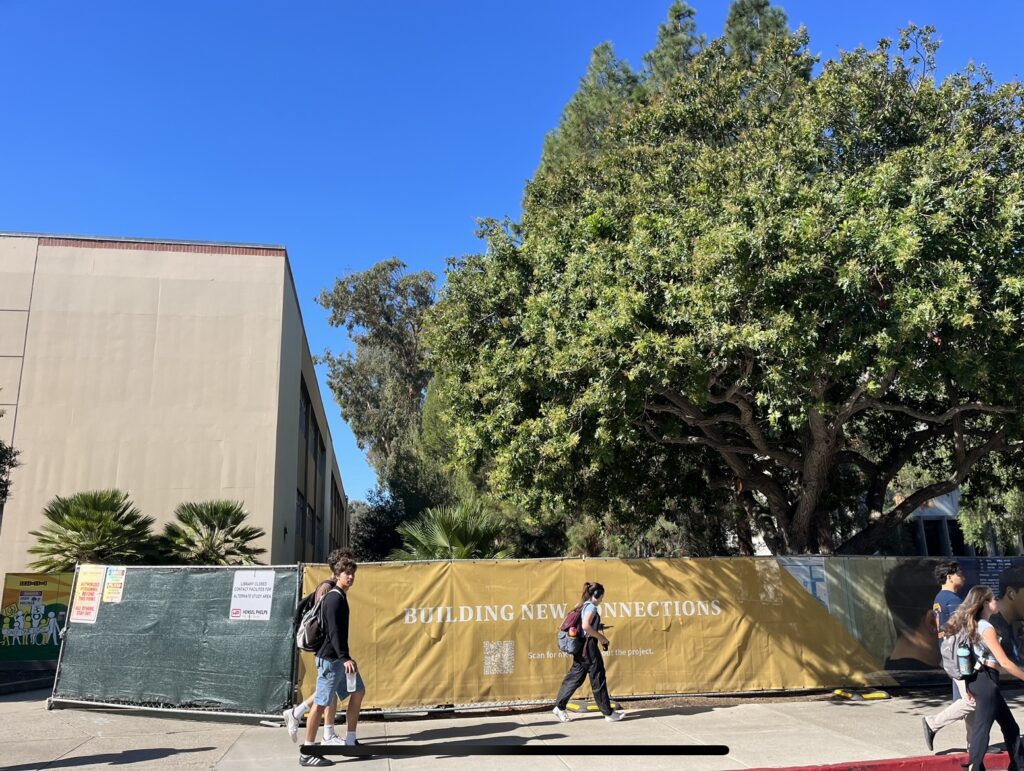
California State University faculty members protest for better salary and working conditions in Sacramento.
Ashley A. Smith/EdSource
For the first time ever, faculty across the entire California State University system on Monday is staging a weeklong labor strike.
The more than 29,000 faculty members in the nation’s largest public university system continue to demand higher wages and for the administration to return to the bargaining table.
For many of Cal State’s nearly 450,000 students, it means missing their first, second or third week of classes this semester or quarter as professors and instructors walk the picket lines across the system’s 23 campuses.
Kate Ozment, an English professor at Cal Poly Pomona, said she hasn’t met her students yet, with the first week of spring classes coinciding with the weeklong strike. Ozment said she posted a notice to her students through the Canvas online learning management system about the strike.
“My goal is to not create confusion with students and my goal is to not harm students,” she said. “I don’t want them on campus because with an empty campus, we win. I sent them information about why we’re striking and that I was participating and I also gave them an overview of the course schedule so they could see how I accommodate the work stoppage.”
Ozment said she won’t be grading, collecting assignments or leading instruction. But she has encouraged her students to work independently this week.
Arabel Meyer, a journalism senior at Cal Poly San Luis Obispo, said all three of her instructors this quarter notified her that they will be striking this week and that classes have been canceled. On the quarter system, students at Cal Poly SLO are in their third week of classes.
“I support the faculty in their striking,” Meyer said, adding that as a college student who can barely afford rent in San Luis Obispo, she understands how difficult it is for a professor making the minimum salary to afford rent in the city. “I can’t even imagine being a college professor and living in the town that I live in and not being paid a wage that is enough to be able to survive and be able to provide for their families.”
Meyer said she’s not worried about a week away from classes hurting her academically, and she’s heard other students celebrate the idea of a “week off.” The real difficulty will be for the professors to “reorganize their schedules and make sure that they’re covering the material that they need to get through in a quarter,” she said.
Nicolette Parra, a political science junior at CSU Northridge, who transferred to university from community college, said she supports the faculty after noticing the problems in CSU.
“There’s a sense of greediness, like the administration just wants more money,” she said. “I am concerned about canceled classes because when the strikes are happening is supposed to be our first week back from winter break. It feels like we are behind. It’s not the professors’ fault, it’s the administration and that worries me.”
Salary and wages remain the top issue dividing the faculty and the administration. The faculty have argued for a 12% general salary increase for this year.
CSU FAculty demands
- 12% pay raises to stay ahead of inflation.
- Pay equity and raising the floor for lowest-paid faculty.
- Manageable workloads that allow for more support and engagement with students.
- More counselors to improve students’ much-needed access to mental health services.
- Expanding paid parental leave to a full semester.
- Accessible lactation and milk storage spaces for lactating faculty.
- Safe gender-inclusive restrooms and changing rooms.
- Safety provisions for faculty interacting with university police on campuses.
Cal State Chancellor Mildred Garcia said that, without question, the faculty deserve a pay increase.
“We are committed to compensating employees fairly, but we are and must be equally committed to the long-term stability and success of the CSU,” Garcia said on Friday during a meeting with reporters. “As a new chancellor four months on the job, I have no interest in a strike. We are ready and willing to come back to the bargaining table with the California Faculty Association, but we must work within our financial realities.”
Garcia said despite the strike, Cal State campuses will remain open this week and provide guidance to students and families and updates about the status of classes.
“The CSU is not canceling classes,” said Christina Checel, CSU’s vice chancellor for labor and employee relations. “Individual faculty members who decide to strike will cancel their own classes. So students should check their class portals or contact their professors to find out whether they intend to hold class.”
Checel said the universities have made contingency plans to continue providing advising, financial aid and other services to students, but the strike “will not interfere with students’ ability to complete their courses or graduate on time.”
Earlier this month, the CSU administration walked away from the bargaining table with the faculty union and offered a 5% pay raise starting Jan. 31. The administration said the salary increase is consistent with agreements CSU reached with five other unions. Over the weekend, CSU also reached an agreement with its skilled trades union, which represents about 1,100 employees.
Faculty say they are insulted by the 5% wage increase.
“Somebody can decide to stop having a conversation with you, but that doesn’t mean the conversation is over,” Ozment said. “They unilaterally decided what was appropriate for us. It was not done in collaboration, it was not done in conversation and it was not done based on any reasonable math from our perspective. What we’re hoping is that this (strike) brings them back to the table. They made a bad choice. They can unmake it.”
A 5% pay raise would have no impact on professors’ ability to make a living when campuses are raising other costs on them, faculty said. Kevin Weir, a Sacramento State professor on the faculty union’s bargaining team, said campuses are raising parking costs, which wipes out any benefits of a 5% increase for those instructors that are already struggling with the cost of living.
But meeting the faculty union’s demands would cost the system about $380 million in the first year and every year thereafter, an amount the system can’t currently afford, said Leora Freedman, CSU’s vice chancellor for human resources.
“The CSU currently spends 75% of its operating budget on compensation,” Freedman said. “If we were to agree to the increases that these unions are demanding, we would have to make severe cuts to programs. We would have to lay off employees. This would jeopardize our educational mission and cause hardship to many employees.”
Freedman said CSU has made several proposals to the faculty union, but the organization has not been willing to reduce its economic demands.
“As soon as either union demonstrates that they’re ready to make meaningful movement in bargaining, we will be back at the table,” she said.
Weir said he disagrees with the university system’s financial arguments. In October, the union released its own independent study conducted by an Eastern Michigan University professor that examined Cal State’s cash flows and reserves. That study, which CSU has described as incorrect, concluded that CSU has about $8.2 billion in reserves and cash investments.
“They have more money coming in than going out every year,” Weir said. “They have enough money to give this chancellor 30% more than her predecessor, and her predecessor got 30% more than her predecessor. They have given campus presidents up to 29% increases. They have no problem rewarding the senior executives of the system, but they do have a problem paying faculty just to keep up with inflation. So, no, I don’t buy their argument.”
Much of the wage dispute comes as CSU has granted salary increases to campus presidents and hired the new system chancellor with a nearly $800,000 base salary, even as the system faced a budget deficit.
Steve Relyea, CSU’s vice chancellor and chief financial officer, said the faculty union has misrepresented the university system’s financial situation. Much of the $8 billion the faculty have cited as available for salaries can’t be used for salaries because it is already committed to CSU’s debt obligations, capital projects, and other contractual commitments like financial aid, housing and parking, he said.
“To use those one-time dollars for ongoing commitments would be reckless and put the institution and our students at risk,” Relyea said.
Even if an agreement is reached between the faculty union and the CSU, negotiations for the next faculty contract are expected to start this spring. Weir said union membership will begin receiving surveys to submit their ideas and thoughts on what changes and demands need to be made in the next contract. Weir said it wouldn’t be the first time that the union and the university system negotiated on two separate contracts simultaneously, with the last time occurring in 2011.
“But I would rather not do that,” he said. “I would rather settle this contract and then move on to the successor contract. I would love to get back into the classroom and be done with negotiations for a while. But in order for that to happen, I need a willing negotiation partner and, so far, management is walking away from the table and indicating they’re not willing.”
Faculty and students have indicated and are aware that if the salary disagreement between CSU and the union isn’t solved, there may be future strikes.
“My students are still facing rising tuition and my peers are still driving for Uber and going to local food banks,” Ozment said. “I think that people should anticipate bigger and longer strike actions if we don’t actually get what we need to run this system because we have it. They have the money. They’re just choosing to hoard it like little dragons from ‘Lord of the Rings.’ ”
California Student Journalism Corps member Delilah Brumer, who is a student at Pierce College in L.A., contributed to this report. Arabel Meyer, a source in this story, is also a member of the California Student Journalism Corps.



















